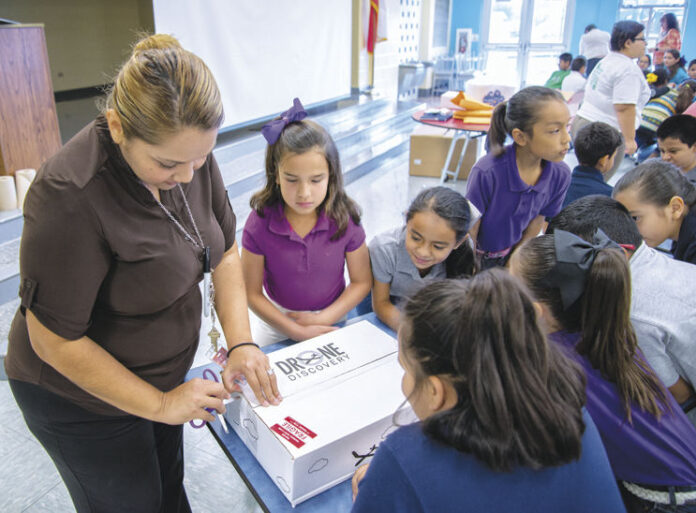SAN BENITO — Science is a subject of the future.
Significant strides have been made in many science realms during the last 100 years.
The subject continues to progress as it becomes more and more popular.
Now, students are learning at younger ages the benefits of studying STEM or science, technology, engineering and math.
“It is here,” said Landrum Elementary School Principal Dr. Eva Basiallon of the growing science industry.
Basiallon was once the lead science official in the district before becoming principal.
She knows a thing or two about educating students about one of her favorite subjects.
Yesterday, about 80 fourth- and fifth-graders at Landrum Elementary participated in the 4-H National Youth Science Day.
4-H is the world’s largest youth-led engineering design challenge, drawing nearly 100,000 participants in 2015.
This year’s challenge, called Drone Discovery, taught the students at Landrum Elementary a wide variety of topics related to unmanned flight including flight dynamics, aircraft types, safety and regulations, remote sensing and flight control.
It’s more than learning the basic science components of observations and questioning.
“It’s also about truly understanding how technology is in their lives. They all know about them, so the sooner we get them to appreciate how cool technology is the more motivated they are to learn,” Basiallon said.
Before, they could get to the fun stuff, the students sat through a presentation via video correspondence with research scientist Ripendra Awal from Texas A&M University Prairie View.
Awal lectured the students mainly about drones and their functions, especially how they are used in agriculture.
“Drones are revolutionizing the way we work and play, whether you are a filmmaker looking for the perfect aerial shot, a rescue worker mapping damage from natural disaster or a farmer determining how to increase crop yield,” said Jennifer Sirangelo, president and CEO, National 4-H Council.
“Drones play an increasingly important role in the world around us.”
The student’s science day included several activities, the lecture, making gliders and then making their very own foam drone which had a small camera attached to it.
With the foam drone, the students were able to fly it, film and then watch what they had filmed afterward.
Landrum Elementary is not behind when it comes to science.
Students here have a jump on several aspects of science some schools only dream about.
“Its not just about drones, the kids have been coding for a year, they have been doing robotics. All of that is essential for them to learn in the 21st century,” Basiallon said.
“We must prepare them for the changes coming. We also have to open their eyes to the possibilities coming and the fact that they can be part of that change.”
These ideas are possible, they are not imaginary.
“The more we expose the children, they’re going to see reasons to learn,” Basiallon said. “If we don’t do this, we are going to fall behind as world leaders.”
How drones are used in agriculture
Soil and field analysis — Drones can be instrumental at the start of the crop cycle.
Planting-startups — Drone-planting systems can achieve an uptake rate of 75 percent and decrease planting costs by 85 percent. These systems shoot pods with seeds and plant nutrients into the soil, providing the plant all the nutrients necessary to sustain life.
Crop spraying-Distance-measuring equipment — Ultrasonic echoing and lasers such as those used in the light-detection and ranging enables a drone to adjust altitude as the topography and geography vary, and thus avoid collisions
Crop monitoring — Vast fields and low efficiency in crop monitoring together create farming’s largest obstacle. Monitoring challenges are exacerbated by increasingly unpredictable weather conditions, which drive risk and field maintenance costs.
Irrigation — Drones with hyperspectral, multispectral, or thermal sensors can identify which parts of a field are dry or need improvements.
Health assessment — By scanning a crop using both visible and near-infrared light, drone-carried devices can identify which plants reflect different amounts of light. This information can produce multispectral images that track changes in plants and indicate their health.




